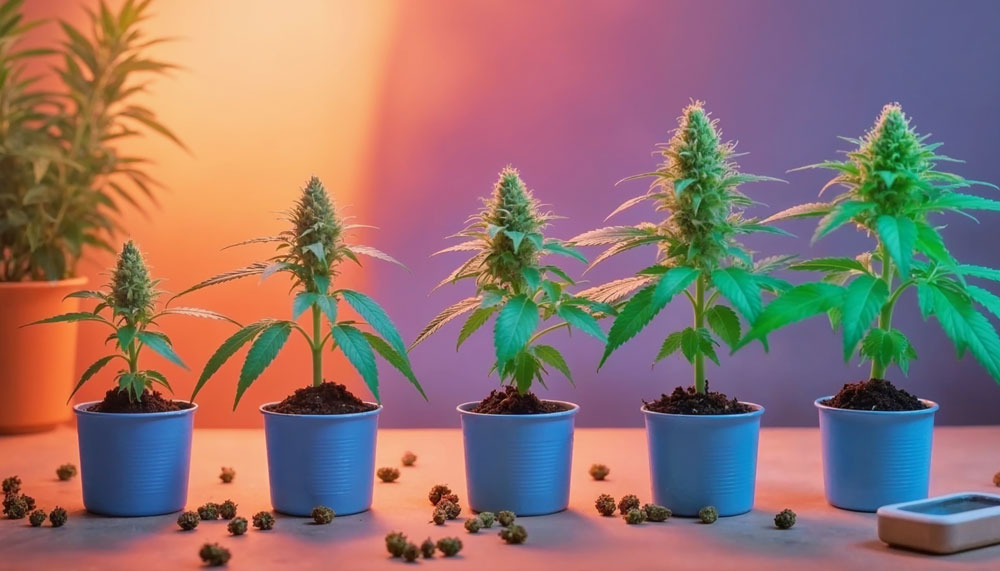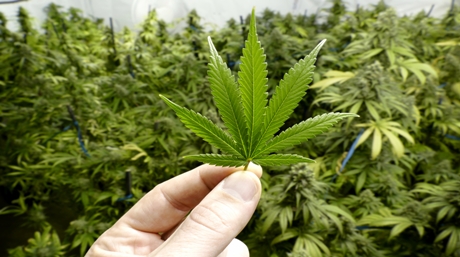Marijuana lovers! Gather around, and let’s talk about the leaves of your legendary pot. It sounds unusual, but there are many things you probably don’t know about the marijuana plant. You might have a million acres of carefully tendered marijuana and still miss out on the fun of knowing your leaves. So, the idea of this review is simple; we will talk extensively about marijuana leaves and get you better acquainted with your favorite marijuana strain. If you wait until the last sentence, you’d understand how best to read your marijuana leaf.
Knowing how to examine the marijuana plant is a skill. Many times, the returns of your investment depend on plant health. Of course, unhealthy plants are more likely to yield low returns. Low returns subsequently shorten your average profit per season. To better track your plant health, you need a better understanding of cannabis leave anatomy. This is why we have written this awesome guide to lead the way. Get strapped in!
How important is the cannabis leaf?
Plant nourishment
Plant science takes the first place in understanding the importance of healthy marijuana leaves for your plant. Just as with every plant out there, cannabis leaves are the main life support system for your weed plant. Healthy leaves directly absorb sunlight to manufacture organic nutrients that serve every part of the plant. This nutrient-manufacturing role is strictly limited to the leaf and other parts of the plant with chlorophyll –a green pigment needed for nutrient production. The big science term describing this complex process is called; Photosynthesis, so the leaves are the natural solar panels generating organic nutrients for your plant. They don’t just look the part; they act the part!
Healthy leafs, healthy returns
If marijuana leaves directly make nutrients for the plant, then it is logical to understand they also determine plant yield. The nutrients produced by the leaves are transferred to other parts of the marijuana plant. With healthy leaves, you are sure to have the best yield in leaf, flower, and stem. Your harvest might eventually depend on how healthy your leaves have become during the growing season.
Cannabis leaves are the mascot of the 420 culture
A cannabis leaf is an irreplaceable symbol of the 420 culture. Consider how the Big M reminds you instantly of McDonald’s fast-food chain. That is exactly how important sketches of marijuana leaves remind us of the emerging global marijuana industry. More than just a symbol, many joint smokers consider the cannabis leaf an identity.
Cannabis leaf anatomy
How well do you know your cannabis leaf? How well can you identify the different parts of the weed leaf? Generally, leaves are compound, with multiple leaflets, as opposed to other plants that grow a single leaf on each leaf node. On every pot plant, the leaves are developed in pairs – each at opposite sides of the stem.
There is vertical space between the leaf pairs. During the vegetative stage, as the cotyledons open, the leaves are first developed as serrated leaves. With time, more and more leaves are formed. Here are the most important anatomic parts of your leaves.
- Petioles: Petioles are the attachment points connecting the leaves to the larger stem surface. Technically, leaves appear to grow out from the junction. In addition to serving as an anchor point, Petioles also help the leaves maintain balance and contribute to nutrient transfer from the leaves down the plants.
- Midrib: From the petioles, you have the midrib. Just as the term suggests, it describes a large vein running parallel in the leaves’ direction from the base to the apex.
- Veins: Veins arise directly from the midrib, crisscrossing into each leaflet. They are popularly described as the circulatory system of leaves. Venous branching from the midribs has different patterns and can be structurally different between weed strains.
- Lamina: The flat part of the leaves is called Lamina. It directly helps you measure the surface area and size of your marijuana leaves. Functionally, the lamina supports the veins and gives shape to the leaf.
- Margin: The leaf margin is the leaf edges – the outermost verges of the leaf from every direction. This part is the reference point for classifying marijuana leaves into Types. Weed leaf margins can be smooth, serrated, curved, or rough.
- Tip: Also called the ‘Apex,’ the cannabis leave tip is the pointed end of the leaf – the farthest point from the petiole. It is the point where the midribs end and the margins meet.
The parts listed above are the leaves’ outer parts. Although leaves are fragile, they are made of complex layers of cells. Layers of cells below the surface are microscopic, so you don’t get to see them always. Other important parts of the plant hidden below the surface include epidermal cells, guard cells, palisade mesophyll, spongy mesophyll, and vascular bundles.
Types of cannabis leaves
You probably might have noticed that cannabis leaves appear in different shapes, patterns, thicknesses, and colors. Observations might have stimulated your curious mind to ask how many types of marijuana leaves there are. There are three main types of cannabis leaves lumped together as Cannabis sativa L. For the sake of making distinctions, the three recognized types of marijuana leaves include Sativa, Indica, and Ruderalis.
- Sativa: Sativa is arguably the most popular leaf type in the marijuana world. Sativa leaves are slender-fingered and long. Compared with other types, the Sativa weed leaf can be easily understood. Watch out for the multiple fingers. A typical Sativa leaf can develop up to 12 fingers on a single leaflet. If your marijuana plant develops a Sativa-type leaf, your plant will likely have a prolonged flowering period. This is because this leaf type has less chlorophyll compared with others.
- Indica: Indica-type leaves are shorter and have a wider lamina compared to other types. Usually, they develop a few fingers (up to 9). If healthy, Indica-type leaves are darker, with a deeper shade of green. This signals a rich deposit of chlorophyll, subsequently giving the plant a faster flowering boom period. In thickness, they are heavy and large, giving them a feature for quick identification.
- Ruderalis: Ruderalis marijuana leaves are thin, develop only about five fingers, and are narrow on the side. The features of this leaf type are very similar to the Indica leaf type. Perhaps the most distinguishing feature of the ruderalis leaves is their auto-flowering ability. They are the popular auto-flowering weed strains. Regardless of the number of hours of sunlight received, these leaves naturally produce flowers.
Mutated cannabis leaf types
It is not common to find marijuana leaf types that do not fit the above categories. Remember that Indica, Sativa, and Ruderalis only describe the main marijuana leaf types. But there is much more. Mutation in plant physiology can lead to great variation in plant morphology. Mutations can give you plant parts with patterns of little or no semblance to the known parts. Many times, a mutation in a plant can give parts that are considered desirable. Other pot leaf types you can get include;
Webbed cannabis leaves
The webbed-type cannabis leaves, as the name suggests, are usually present in a webbed pattern. The leaf fingers and margin are organized into a webbed pattern. Before the legalization of marijuana in many regions, weed farmers tried to stabilize this mutation. The idea was to disguise weed plants from the prying eyes of the law. Now that you can legally cultivate the traditional varieties, only a few people cultivate the webbed-type marijuana leaf. But you can still find them around.
Whorled cannabis leaves
This type looks almost like the regular weed leaf type. However, on close examination, you might notice a few differences. This leaf type seems to develop multiple leaflets from a common petiole. Only a few marijuana farmers still cultivate this leaf type. Although no verified scientific backing exists, many believe the whorled pot leaf flowers have improved potency compared to others.
Australian bastard cannabis leaves
You probably would not believe this leaf type can ever be found growing on a cannabis plant. First recognized by breeders in Sydney, the features here are significantly different from the regular marijuana strains. The leaflets are succulent and hairless, spotting about 5fivefingers that are only a few centimeters long. Attempts to stabilize this leaf type have not yielded any significant commercial success.
How to read your marijuana leave for clues on plant health
Marijuana leaves can help you better understand how healthy your plant is growing. Simple enough, if you know where to look on the leaf, you can read your cannabis plant and diagnose any growth problem. Here are the most common hints to look out for on your cannabis leaf.
- Yellowish leaf/ Yellow patches: If your leaf turns yellowish or develops several patches of yellow colors, it means there is something wrong with your plant. You should understand that it is normal for the marijuana leaf to turn yellow during the late weeks of flowering. Except during this time, your cannabis leaf is not expected to be yellow. Over-fertilization is perhaps the most common reason for this. If you apply too much fertilizer to your plant, the yellowish coloration starts gradually from the tip before the whole leaf turns yellow during the later stages of over-fertilization. Over-watering, nutrient deficiency, and root rot are the other common reasons your cannabis leaves might turn yellow.
- Curly leaves: Curly leaves on the cannabis plant can present themselves in many ways. The leaves might bend sideways, upwards, or down on the edges. Irregular curvation of the leaves during any flowering stage signals growth impairment. Exposure of the plant to extremes of temperature for a prolonged period is perhaps the most common cause of crumbling leaves. In indoor growth methods, heat stress can occur if your plant is too close to the grow lights. Overwatering and exposure to negative temperatures can also cause your cannabis leaves to crumble.
- Wilting leaves: Wilting leaves suggest something is wrong with your cannabis plant. The leaves suddenly lose vigor and grow slowly and wilt away. Verticillium, a serious disease caused by a soil fungus, is considered an important cause of wilting leaves. This fungus attacks the roots and disrupts the normal flow of nutrients tapped from the soil. The leaves first appear yellowish, then fade and wilt away slowly. If unchecked, wilting leaves can significantly decrease harvest yield.
- Discolored mottled leaves: This plant abnormality causes the leaves to become discolored and mottled. Mottling appears as spot holes, irregular holes, or shallow ridges on the lamina. You might need to closely observe the leaves before you can be sure it is mottled. If the Leaf Miner Larvae infest your plant, the leaves will likely become discolored and mottled. This larva bore tunnels through the leaf, leaving behind a trail of discolored marks in irregular shapes along the lamina. Pest infestations are generally responsible for mottling. Caterpillars, thrips, and aphids are notorious pests that can cause mottling and leaf discoloration.
- Nutrient deficiencies: You can also easily track the nutrient health of your cannabis plant. If the plant lacks Boron, large brown or gray spots appear on the cannabis leaf. In Magnesium deficiency, the leaves become yellow and gradually turn dry and crunchy. If your plant lacks Molybdenum, the cannabis leaves will likely turn brown and develop crispy margins with shades of pink or orange on the lamina.
The bottom line
There is a lot your cannabis leaf can tell you about the plant if only you knew where to look. Caring for your cannabis plant can become easier if you pay attention to what the leaves suggest. This in itself can help reduce production costs and increase harvest yield. Knowing your cannabis leaves can also help you select the best strains for your next growing season. All you have to do is listen to your cannabis leaves. Learn to read the signs, and you will be fine.















